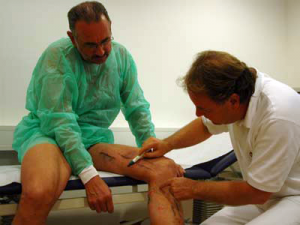 Inspection is the most important since it may reveal ulceration, spider veins, skin alteration (white atrophy), fungal involvement like inter-digital mycosis, acrocyanosis, eczematous lesions, micro-ulcers, stasis dermatitis, flat angiomata, prominent varicose veins, scars from a prior surgical operation, or evidence of previous sclerosant injections. Measuring and photographing lesions is recommended because patients undergoing treatment for varicose and spider veins often forget the original appearance of their legs and feet and may report that pre-existing lesions were caused by treatment
Inspection is the most important since it may reveal ulceration, spider veins, skin alteration (white atrophy), fungal involvement like inter-digital mycosis, acrocyanosis, eczematous lesions, micro-ulcers, stasis dermatitis, flat angiomata, prominent varicose veins, scars from a prior surgical operation, or evidence of previous sclerosant injections. Measuring and photographing lesions is recommended because patients undergoing treatment for varicose and spider veins often forget the original appearance of their legs and feet and may report that pre-existing lesions were caused by treatment
Normal veins typically are visibly distended at the foot and ankle and occasionally in the popliteal fossa. For other regions of the leg, visible distension of superficial veins usually implies disease. Translucent skin may allow normal veins to be visible as bluish sub-dermal reticular pattern, but dilated veins above the ankle usually are evidence of venous pathology.
Discoloured skin often is a sign of chronic venous stasis, particularly if it is localized along the medial ankle and the medial aspect of the lower leg. Non-healing ulcers in this area are most likely due to underlying venous stasis. Skin changes or ulcerations that are localized only to the lateral aspect of the ankle are more likely to be related to prior trauma or to arterial insufficiency than to pure venous insufficiency.
The entire surface of the skin is lightly palpated with the fingertips because dilated veins may be palpable even where they are not readily observed. Palpation helps to locate both normal and abnormal veins. After light palpation to identify superficial vascular abnormalities, deeper palpation helps to elucidate the causes and sources of the superficial problems.
Venous percussion is useful to determine whether 2 venous segments are directly interconnected. Percussion can be used to trace the course of veins already detected on palpation, to discover varicose veins that could not be palpated, and to assess the relationships between the various varicose vein networks. Percussion can be used to elucidate the course of any significant superficial vein.
The Perthes Manoeuvre is a traditional technique intended to distinguish antegrade flow from retrograde flow in superficial varicose veins. Antegrade flow in a variceal system indicates that the system is a bypass pathway around deep venous obstruction. This is critically important because, if deep veins are not patent, superficial varicose veins are an important pathway for venous return and must not be sclerosed or surgically removed.
The Trendelenburg Test can often be used to distinguish patients with superficial venous reflux from those with incompetent deep venous valves.